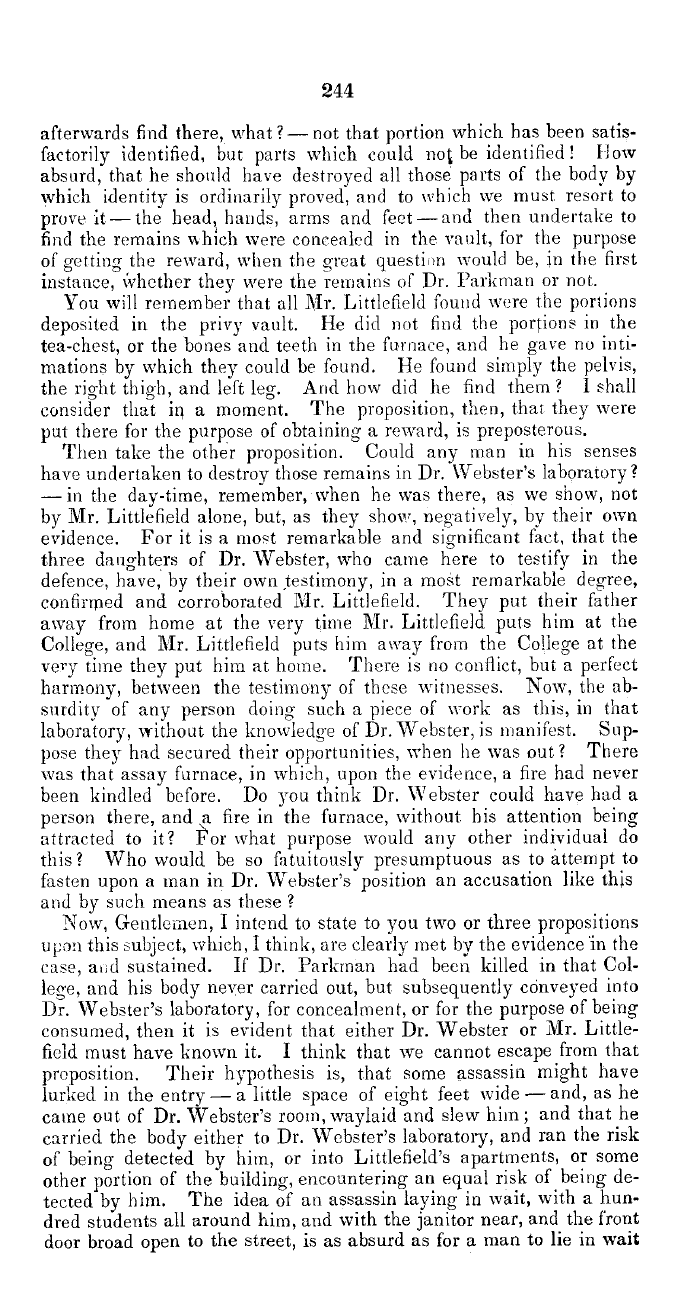|
244
afterwards find there, what?-not that portion which has been satis-
factorily identified, but parts which could not, be identified! L°ow
absurd, that he should have destroyed all those parts of the body by
which identity is ordinarily proved, and to which we must resort to
prove it-the bead, hands, arms and feet-and then undertake to
find the remains which were concealed in the vault, for the purpose
of getting the reward, when the great questinn mould be, in the first
instance, whether they were the remains of Dr. Parlzman or not.
You will remember that all Air. Littlefield found were the portions
deposited in the privy vault. He did not find the portions in the
tea-chest, or the bones and teeth in the furnace, and he gave no inti-
mations by which they could be found. He found simply the pelvis
the right thigh, and left leg. And how did he find them? I shall
consider that in a moment. The proposition, then, that they were
put there for the purpose of obtaining a reward, is preposterous.
Then take the other proposition. Could any man in his senses
have undertaken to destrov those remains in Dr. Webster's laboratory?
-in the day-time, remember, when he was there, as we show, not
by Mr. Littlefield alone, but, as they show, negatively, by their own
evidence. For it is a most remarkable and significant fact, that the
three daughters of Dr. Webster, who came here to testify in the
defence, have, by their own testimony, in a most remarkable degree,
confirmed and corroborated Mr. Littlefield. They put their father
away from home at the very time Mr. Littlefield puts him at the
College, and Mr. Littlefield puts him away from the College at the
very time they put him at home. There is no conflict, but a perfect
harmony, between the testimony of these witnesses. Now, the ab-
surdity of any person doing such a piece of work as this, in that
laboratory, without the knowledge of Dr. Webster, is manifest. Sup-
pose they had secured their opportunities, when lie was out? There
was that assay furnace, in which, upon the evidence, a fire had never
been kindled before. Do you think Dr. Webster could have bad a
person there, and a fire in the furnace, without his attention being
attracted to it? Per what purpose would any other individual do
this? Who would be so fatuitously presumptuous as to attempt to
fasten upon a man in Dr. Webster's position an accusation like this
and by such means as these ?
-Now, Gentlemen, I intend to state to you two or three propositions
ul;on this subject, which, I think, are clearly met by the evidence in the
case, aid sustained. If Dr. Parkman had been killed in that Col-
lege, and his body never carried out, but subsequently conveyed into
Dr. Webster's laboratory, for concealment, or for the purpose of being
consumed, then it is evident that either Dr. Webster or Mr. Little-
field must have known it. I think that we cannot escape from that
proposition. Their hypothesis is, that some assassin might have
lurked in the entry - a little space of eight feet wide - and, as he
came out of Dr. Webster's room, waylaid and slew him; and that he
carried the body either to Dr. Webster's laboratory, and ran the risk
of being detected by him, or into Littlefield's apartments, or some
other portion of the building, encountering an equal risk of being de-
tected by him. The idea of au assassin laying in wait, with a hun-
dred students all around him, and with the janitor near, and the front
door broad open to the street, is as absurd as for a roan to lie in wait
|

